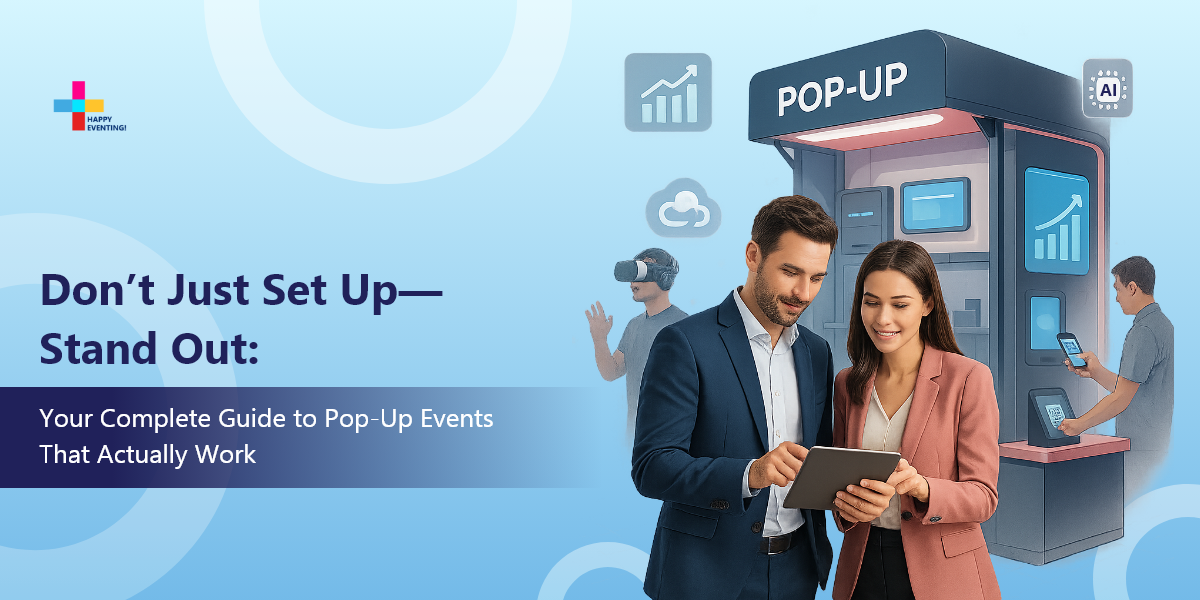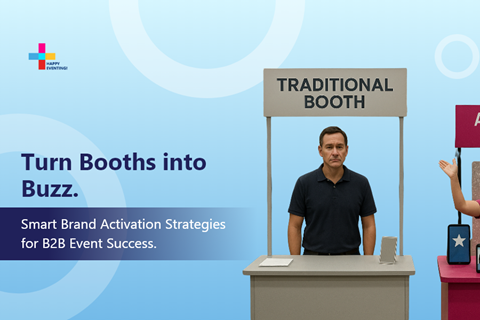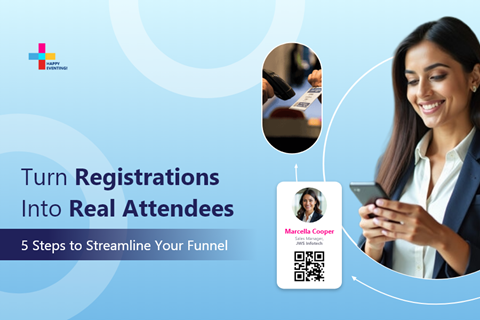

- {{UserName()}}
Request a Demo




Imagine turning an ordinary sidewalk into the most talked-about brand stage of the season. That's the power of a pop-up event. Temporary, nimble, and strategically deployed, pop-ups are no longer just a trend—they've become a serious asset in the B2B marketer's arsenal.
From a coffee cart with lead capture at a leadership summit to a surprise product experience in the heart of a city, pop-ups are rewriting how brands show up, drive buzz, and build business momentum.
This guide breaks down what pop-up events are, their powerful benefits, how to execute them, and how you can plan your own to spark buzz, generate leads, and leave a lasting mark.
A pop-up event is a short-term, temporary activation hosted by a brand, company, or organization to connect directly with a targeted audience. It often appears in unconventional or high-traffic locations like city streets, trade show floors, lobbies, or festivals.
You might stumble upon one in a quiet café corner or an open plaza that suddenly feels alive with color, conversation, and creativity. It's that element of surprise that makes them so magnetic.
Unlike traditional events that demand long lead times and hefty budgets, pop-ups are agile, low-risk, and easier to test. A tech brand, for instance, might host a one-day demo inside a co-working hub, creating a casual but focused environment where decision-makers feel personally invited rather than marketed to.
With 90% of marketers saying experiential marketing delivers more compelling engagement benefits, pop-ups are a powerful tool in today's marketing playbook.
Let's take a closer look at those benefits.
Creating Unique Customer Experiences
Pop-up events invite people to slow down, stay a while, and truly experience what a brand feels like. They give attendees a chance to touch the product, soak in the vibe, and connect—not just through pitches, but through genuine eye contact and real conversations. It's not about fast decisions or forced handshakes; it's about creating moments that feel personal. These small, thoughtful interactions can leave a lasting impression and quietly build trust in a way no ad ever could.
Enhancing Brand Visibility
Attendees will notice your brand colors and logo even before they walk up to your pop-up. That first visual impression matters. A well-placed pop-up in a busy area naturally boosts brand recall, simply because people see it—even from a distance. And if someone snaps a photo and shares it online, that's personal word-of-mouth, amplified digitally. So, when you think of pop-up events, imagine a surprise setup at a trade show that gets people stopping, clicking, posting, and talking.
Driving FOMO (Fear of Missing Out)
We all know the golden rule—when something's in short supply, people want it more. Pop-up events operate on that principle. Their temporary nature gives you built-in urgency without needing gimmicks. That sense of "blink and you'll miss it" builds instant FOMO, nudging prospects to act fast. You can push limited-time offers, exclusive drops, or in-person-only perks, because people act faster when they know the opportunity won’t be around tomorrow.
Cost-Effective Market Testing
Every great outcome starts with a powerful idea. But even the smartest ideas need to be tested before they grow. Pop-up events let you test new product lines, pricing strategies, messaging, or target demographics in a low-risk environment. You can run small pilots, track footfall, observe buying behavior, and gather performance data—all without investing in a permanent location or full campaign. This allows you to optimize before scaling, which protects your budget and improves ROI on future initiatives.
Getting Direct Customer Feedback
Pop-up events put you face-to-face with your audience, giving you a rare chance to hear their thoughts in real time. Instead of relying on surveys or online reviews, you’re observing behavior, asking follow-up questions in real time, and identifying patterns on the spot. This leads to faster product tweaks, more targeted messaging, and better overall alignment with customer expectations. For marketers and product teams, this feedback loop is priceless—and much faster than waiting weeks for post-campaign analytics.
Pop-up events have evolved beyond fleeting retail gimmicks. Below is a breakdown of key formats and their business impact.
Permanent pop-ups are long-term temporary setups (typically 6 to 24 months) that mirror traditional storefronts without the long-term lease or infrastructure burden. Think of them as agile retail labs—ideal for building presence while maintaining flexibility.
Business advantages:
Best used when:
You’re piloting a retail presence, exploring new markets, or building brand familiarity over an extended period without locking into fixed costs.
Seasonal pop-ups are short-term activations aligned with high-traffic periods such as holidays, festivals, or tourism seasons—built to capture demand while it’s peaking.
Business advantages:
Best used when:
You want to capture short-term sales, align with seasonal trends, or test limited-time product offerings with minimal overhead.
Marketing event pop-ups are campaign-driven activations designed to create buzz, drive engagement, and amplify your brand narrative in real-world settings.
Business advantages:
Best used when:
You’re launching a product, running an awareness push, or need a physical experience to amplify a digital campaign.
Pop-in stores are compact activations hosted inside existing retail or office spaces that tap into the host venue’s foot traffic and customer base.
Business advantages:
Best used when:
You want to enter new spaces quickly, test a product with a niche audience, or build brand familiarity with minimal investment.
Virtual pop-ups are online-only activations—like webinars, gated content hubs, or interactive demos—that replicate the engagement of in-person events in a fully digital space.
Business advantages:
Best used when:
Your audience is distributed, remote-first, or digital-native, and you need scalable engagement without physical logistics.
Experiential pop-ups are immersive setups focused on creating emotional connection through storytelling, design, and audience participation—more about impact than immediate sales.
Business advantages:
Best used when:
You’re building emotional resonance, launching a lifestyle brand, or trying to generate long-term affinity and share-of-mind.
Product demo pop-ups are hands-on environments that let prospects engage with your product or service in real time—ideal for building trust and accelerating purchase decisions.
Business advantages:
Best used when:
You’re selling high-consideration products, educating buyers, or trying to shorten the sales cycle through firsthand experience.
Pop-up events operate on compressed timelines but deliver significant marketing outcomes when executed with intent. Whether the goal is lead generation, product validation, or brand engagement, success depends on execution across several key areas.
1. Define Business Goals, Not Just Event Goals
Start with the why and make it measurable. Whether you're launching a product, gathering customer feedback, or increasing brand visibility, defining your primary objective sets the tone for execution.
Quantifiable KPIs—like conversion rate, attendee volume, average engagement time, or qualified leads generated—enable marketing teams to assess performance and optimize in real time.
Key takeaways:
2. Solve an Actual Problem, Not Just a Moment
Effective pop-ups go beyond awareness. Begin by identifying key audience challenges, such as lack of product awareness, decision fatigue, or low digital engagement. Then position your event experience as a tailored solution.
This approach doesn't just drive footfall—it increases perceived value and post-event retention.
Key takeaways:
3. Choose Venues That Multiply Visibility and Access
The venue isn't just a backdrop—it's a channel. High-traffic areas and relevant environments significantly improve reach and engagement without additional media spend.
Prioritize locations with strong overlap between your target demographic and natural footfall—think transit hubs, cultural hotspots, or business districts.
Key takeaways:
4. Optimize for Agility with Temporary or Mobile Spaces
Temporary setups like mobile vans, branded tents, or shipping containers offer logistical flexibility and cost-efficiency. These formats excel at grassroots engagement and can be replicated across cities or markets with minimal lift.
When used strategically, mobile activations can create fast brand touchpoints and encourage immediate interactions.
Key takeaways:
5. Collaborate with Permanent Venues for Instant Infrastructure
Partnerships with established venues—cafés, galleries, co-working spaces—offer built-in infrastructure and reputational credibility. These spaces provide high foot traffic, core amenities, and an aligned audience without the overhead of building from scratch.
This strategy streamlines logistics and elevates the perceived quality of the experience.
Key takeaways:
Leveraging built-in amenities (restrooms, power, Wi-Fi) drastically cuts setup time and costs.
Enhance brand legitimacy through association with trusted locations.
Shared marketing opportunities amplify promotional efforts.
6. Streamline Operations and Compliance
Behind-the-scenes planning makes or breaks execution. Ensure power access, internet connectivity, staff onboarding, and signage are resolved early. Importantly, review city-specific regulations around temporary installations to avoid last-minute disruptions.
An operational checklist with deadlines and owners improves accountability and readiness.
Key takeaways:
7. Design for Immersion and Retention
The experience is the product. Cohesive branding, interactive elements, and spatial storytelling increase dwell time and post-event engagement. Whether it's product demos, AR filters, or tactile displays—give people a reason to stay, interact, and share.
Brand recall is significantly higher when customers participate, not just observe.
Key takeaways:
Pop-up events thrive on being quick and getting instant attention. Event technology isn't just about managing things behind the scenes; it's about making your pop-up truly powerful. It helps you set up fast, makes every brief interaction count, and grabs valuable information right away. Think of tech as your hidden partner, making sure your pop-up runs smoothly and gives you real results, whether it's on a busy street or at a major conference.
Quick Sign-Ups & Smooth Entry
For pop-ups, getting people in fast is key. Modern mobile-friendly registration platforms let visitors sign up on their phones or pre-register easily, cutting down on lines that might scare off spontaneous guests. QR code scanning and touchless check-ins are perfect for pop-ups. They offer instant access and quietly collect visitor data without slowing things down. This means a seamless first impression and no bulky equipment needed.
Interactive and Personalized Experiences
Pop-ups need to grab attention immediately. Interactive digital screens and kiosks are essential. They act as self-service points where people can find product info, fill out a quick form, or get special content. This turns passive watchers into active participants. Augmented Reality (AR) filters and fun games (accessed via QR codes or simple apps) create moments people want to share online. This spreads your pop-up's buzz far beyond its physical spot. These tools also help you do more with less staff in a small area.
Lead Capture and Follow-Up Automation
The short window of a pop-up means you need to collect leads right away. Dedicated event apps or simple QR code scanners let your staff gather qualified leads instantly, adding notes about conversations or specific interests. The best part? This information can immediately trigger automated, personalized emails or texts after the interaction. This speed ensures every connection made at your pop-up turns into a clear path for sales or nurturing, so leads don't go cold.
Data and Analytics
Pop-ups are perfect for testing new ideas. Event tech gives you live data dashboards that show how well things are working, which displays are popular, and how many people are coming through. This instant feedback means you can make smart, quick changes: move staff, adjust a display, or offer a new deal to match what's happening. This "test-and-learn" cycle, powered by tech, helps you get the most out of every temporary event.
Pop-up marketing must create urgency, relevance, and measurable impact to justify investment. Whether launching a product, testing market interest, or building brand awareness, the marketing strategy should directly support key outcomes like conversions, brand recall, and ROI.
Building Anticipation with Pre-Event Teasers
Because pop-ups are temporary, building anticipation is crucial. Start your promotional campaign at least two weeks out with cryptic social posts, countdown timers, and "coming soon" emails that hint at an exclusive, limited-time experience. Leverage geofencing ads to target potential attendees in the immediate vicinity or key areas like co-working spaces. Track metrics like pre-registrations, email open rates, landing page visits, and conversion rates from teaser campaigns to attendance to understand interest and engagement levels.
Leveraging Influencers and Media
For pop-ups, local relevance is key. Partner with niche or community influencers (e.g., local food bloggers, tech reviewers, community leaders) and secure coverage in local news outlets or targeted industry publications. Their endorsement adds instant credibility and amplifies your reach to trusted, highly relevant audiences who are likely to be physically present. Measure referral traffic from these channels, track attendee acquisition through promo codes or links, and assess brand sentiment and media share of voice before and after the event to gauge impact.
Amplifying Reach on Social Media
Treat the pop-up as a dynamic live content hub that's happening right now. Share behind-the-scenes glimpses during setup, host live Q&A sessions from the event floor and constantly push high-energy highlights and attendee experiences with a dedicated, memorable hashtag. Strategically place branded photo opportunities and interactive elements that encourage user-generated content (UGC) – this is your most authentic, organic amplification. Monitor hashtag usage, social engagement, and social referral traffic to measure effectiveness.
Encouraging Authentic Word-of-Mouth
High-quality attendance and powerful post-event advocacy come from delivering an exclusive, valuable experience that people genuinely want to talk about. Go beyond basic interactions; offer limited-time discounts, unique product trials, or personalized consultations. Equip attendees with simple referral tools like shareable social templates or unique QR codes that offer a perk for bringing a friend. Track referral-driven registrations, social shares, and post-event feedback to evaluate attendee satisfaction and likelihood to recommend.
And there you have it: your comprehensive blueprint for transforming fleeting moments into tangible business growth. When you combine strategic planning, the ideal pop-up format, cutting-edge event technology, and precise marketing, you unlock a powerful channel for growth that traditional methods can't match.
It's time to stop just "popping up" and start standing out. Discover how Eventcombo can empower your team to execute flawless events, from intimate pop-ups to major trade shows. Let's make your next activation unforgettable.

Brand presence is easy. Brand impact takes strategy. That’s where brand activation comes in. It pulls in decision-makers, creates hands-on engagement, and converts event buzz into a pipeline. Static booths don’t cut it.

Imagine turning an ordinary sidewalk into the most talked-about brand stage of the season. That's the power of a pop-up event. Temporary, nimble, and strategically deployed, pop-ups are no longer just a trend—they've...

Let’s be honest: there was a time when great content and a catchy title were enough to pull in a crowd. But today, events have become a go-to marketing play, and now, everyone’s in the game.